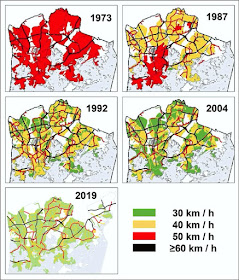- Evolution of European Motorways 1920-2020
- Dataviz of spatial and temporal spread in networks
- paper: Open office architecture seems to decrease the volume of face-to-face employees' interaction and increase electronic interaction.
- Global Mapping of GDP at 1 km2 Using VIIRS Nighttime Satellite Imagery
- Microsoft releases 18M building footprints in Uganda and Tanzania to enable AI Assisted Mapping
- OpenRailwayMap, the open online map of the worldwide railroad infrastructure
- In 2019, Helsinki had 0 pedestrian or cyclist fatalities for the first time since 1960. How Lowering speeds and traffic calming.
Structured Procrastination on Cities, Transport Policy, Spatial Analysis, Demography, R
Sunday, February 23, 2020
Assorted Links
Thursday, February 13, 2020
Apply for the 2020 Lee Schipper Memorial Scholarship for Sustainable Transport and Energy Efficiency
Since 2012, WRI Ross Center for Sustainable Cities awards a young researcher every year with the Lee Schipper Memorial Scholarship for Sustainable Transport and Energy Efficiency. This award was created to celebrate Lee Schipper, one of the founders of EMBARQ and an enthusiastic supporter of building closer links between rigorous research and policy-making. The Scholarship awards up to two candidates a maximum of $10,000 each to advance transformative research in efficient and sustainable transport. Applications are due by March 18, 2020.
I was honored along with Joanna Moody to receive this award in 2017. It was a great and enriching experience and I would strongly encourage other researchers to apply for the Lee Schipper Award.
Monday, February 10, 2020
Monday, February 3, 2020
Hacking the system with virtual traffic congestions
In a brilliant artistic performance, Simon Weckert generated virtual traffic jams in Google Maps by pulling a wagon full of smartphones. HT Steven Crowley.
Sunday, February 2, 2020
Estimating total fertility rates from population pyramids
Matt Hauer and Carl Schmertmann (both on Twitter) have just published a new paper that promises to be a game changer in population studies. They devised a method to estimate total fertility rates using inputs as minimal as the age/sex structure of a population. They tested the accuracy of the method using 2400+ fertility schedules and the result is incredibly accurate. Matt has written a thread on Twitter summarizing some of the key aspects of the paper. The code to replicate the paper is here and an ungated preprint of the paper can be downloaded here.
Hauer, M., & Schmertmann, C. (2018). Population pyramids yield accurate estimates of total fertility rates. Demography. https://doi.org/10.1007/s13524-019-00842-x []
Abstract:
The primary fertility index for a population, the total fertility rate (TFR), cannot be calculated for many areas and periods because it requires disaggregation of births by mother’s age. Here we discuss a flexible framework for estimating TFR using inputs as minimal as a population pyramid. We develop five variants, each with increasing complexity and data requirements. We test accuracy across a diverse set of data sources that comprise more than 2,400 fertility schedules with known TFR values, including the Human Fertility Database, Demographic and Health Surveys, U.S. counties, and nonhuman species. We show that even the simplest and least accurate variant has a median error of only 0.09 births per woman over 2,400 fertility schedules, suggesting accurate TFR estimation over a wide range of demographic conditions. We anticipate that this framework will extend fertility analysis to new subpopulations, periods, geographies, and even species. To demonstrate the framework’s utility in new applications, we produce subnational estimates of African fertility levels, reconstruct historical European TFRs for periods up to 150 years before the collection of detailed birth records, and estimate TFR for the United States conditional on race and household income.
Estimated TFR from Population Pyramids. We compare the performance of five variants against observed TFRs using data from the Human Fertility Data, Demographic and Health Surveys, the US Census Bureau, and various non-human species.




